Agricultural Big Data Architectures in the Context of Climate Change: A Systematic Literature Review
Abstract
:1. Introduction
2. Background
2.1. Agricultural Big Data
2.2. Climate Change
3. Methodology
4. Results
4.1. Agricultural Big Data in the Context of Climate Change
4.1.1. Big Data for Water Management
- (a)
- Adaptation: According to Figure 4, five papers selected describe actions for Adaptation in water management. In Coro et al., they use greenhouse effect data flows from a Big Data system that comes from data collections from AquaMaps and NASA. They also use environmental parameters processed through a computation platform in the cloud to generate intermediate scenarios and new informative parameters to show climate change patterns in 10 marine areas. The authors conclude that the Mediterranean Sea may have an independent response to climate change compared to other areas, affecting fishing and other inputs [35]. Senay et al., use Landsat and meteorological Big Data to quantify and understand the relative importance of water management and climate variability on crops. They also use this data to make decisions in water management, hydrological processes, and economic transactions [36].
4.1.2. Big Data for Climate Management
- (a)
- Mitigation: Seven papers selected describe actions of Adaptation, Mitigation, and Resilience in climate management. For Mitigation, the work by Semlali et al., uses Big Data to analyze harmful gas emissions and monitor air quality using remote-sensing techniques [40]. Ma and Nie develop an innovative weather service model based on Big Data that includes collaborating resources, techniques, and services to optimize weather forecast processes, helping farmers in decision making [41].
- (b)
- Resilience: For the case of Resilience, Mousannif and Zahir look for solutions to quantify the impact of climate change on farmers’ quality of life to reinforce climate resistance and improve farmers’ livelihoods. They applied advanced data analyses to provide a deep understanding of the interrelated climate, environmental, social, cultural, economic, institutional, and political factors that exacerbate the differentiated impacts of climate change. As a result, the system can decide about irrigation, crop types, and actions to improve crop production to make the most vulnerable communities more resistant to climate change [42]. In addition, Li and Liao develop a Big Data platform for early warning of agricultural weather disasters, including floods, droughts, warm and dry winds, low temperatures, typhoons, hail, and continuous rain [43].
- (c)
- Adaptation: For the case of Adaptation, Jain and Jain explore several application domains that could benefit from weather forecasting using Big Data analyses, in addition to the challenges to be faced when taking advantage of the weather forecast in these domains [44]. On the other hand, Gad and Manjunatha develop a climate data storage model for Big Data to identify climate patterns useful for agricultural fields, climate change studies, and contingency plans in extreme climate conditions [45]. Mangal and Rajesh develop a Big Data framework to anticipate the potential effects of many climate scenes, including the social, economic, and geographic diversity of the parties involved and the long-term time horizons and irreversible effects [46].
4.1.3. Big Data for Crop Management
- (a)
- Adaptation: Fifteen papers contribute with actions in Adaptation. First, Gulzar et al., determine the optimal health of crops and analyze the impact of climate change on food safety. The authors use a taxonomy to provide recommendations [47]. Second, Delgado et al., develop a WebGIS framework to connect generators of specific local data from crop sites, called smart farms, to a regional and global view of agriculture. They use artificial intelligence, IoT, drones, robots, and Big Data as the foundation for a global “Digital Twin” that contributes to developing specific conservation and management of crop sites [48]. Third, Lopez et al., propose a strategy of merging multi-domain data to support data analysis tasks in agricultural contexts because many crops will no longer adapt to the conditions of a specific territory [49]. Finally, Manogaran and Lopez offer a climate change detection algorithm based on spatial autocorrelation to control changes in the seasonal climate to prevent diseases.
4.1.4. Big Data for Soil Management
- (a)
- Adaptation: For the case of the Adaptation, Bestelmeyer et al., develop Big Data to analyze landscapes, using temporal data sets in a grid or at a regional level together with local information on changes in the pastures that grow on the farms. They discover that there are places where the pastures have decreased, leading to livestock problems [58]. Hu et al., use Big Data to include the recent historical changes in land cover and its interrelations with environmental processes to better support the land-use management strategies in climate change [59].
- (b)
- Mitigation: For the case of Mitigation, Fernándes_Getino et al., use Big Data to analyze the connectivity values associated with healthy ecosystems and with high levels of biodiversity, which can ensure better soil protection, favoring sustainability, implying sustainability, and a more significant C sequestration potential in the soil. Furthermore, they use vulnerability and risk maps to identify the areas most prone to habitat degradation and fragmentation [60]. On the other hand, Kamilaris et al., develop the software AgriBigCAT, which uses geophysical information, geospatial analysis, and Big Data analysis to evaluate the impact of the agricultural livestock sector on the environment by examining possible contamination of the land, water, and air due to manure [61].
- (c)
- Resilience: Concerning Resilience, Li et al., examine the land-based ecological and environmental change through analyses of change trends of land cover and the normalized difference vegetation index. The authors indicate that ecological restoration is undergoing ever-greater challenges due to increasing human activities and the fragile environment [62].
4.2. Agricultural Big Data Architectures
- (a)
- Climate-Smart Agriculture Architecture: The architecture presented by Lopez et al., is based on a previous architecture designed by the authors for smart agriculture, which allows the detection of favorable conditions for planting and crop production in the Cauca River basin. The updated architecture fuses and analyzes data from different dimensions in climate-smart agriculture (CSA) contexts, applying Big Data, Data Mining, and Machine Learning methods. They apply different algorithms for the fusion process [49]. Figure 5 represents the components considered in the four-layer architecture.
- (b)
- Big Data Architecture for Atmospheric Composition Monitoring: Semlali et al., propose a six-layer Big Data architecture: data source layer, ingest layer, Hadoop storage, management, infrastructure, security, and monitoring layer. Big Data enables the processing of pollutant gas emissions data from various sources, such as industry, transportation, and agriculture. In addition, the system continuously monitors atmospheric composition through remote-sensing techniques, providing satellite data on a global scale [40]. Figure 7 represents the proposed architecture.
- (c)
- DSS LANDS Architecture for Forecasting Crop Disease: Fenu and Malloci develop a prototype agricultural DSS in collaboration with Lahore Sardinia Agency [12]. The DSS is designed to help Laore technicians and Sardinian farmers in decision making. The purposes of LANDS are: (1) To optimize resource management by reducing specific inputs, for example, chemical and natural resources, etc.; (2) to predict crop risk situations (for example, diseases, weather alerts, etc.); (3) to increase the quality of decisions for field management; and (4) to reduce environmental impact and production costs. To address the objectives, LANDS is divided into three steps: (1) collects, organizes, and integrates a large amount of data from different sources; (2) analyzes and interprets the information; and (3) uses the analysis to recommend the best action to take. The authors structure the DSS LANDS into three components: (1) an integrated system for monitoring the crop components and storing their data; (2) a data analysis modules system that performs through several mathematical and forecasting models and dynamic analysis of different types of data; (3) a cross-platform application used by farmers to upload crop data collected during the field survey and to visualize the up-to-date information for managing the cultivation. Figure 9 shows the DSS LANDS Architecture for Forecasting Crop Disease.
- (d)
- Big Data Architecture for Crop Yield Prediction: In Alex et al., they use a Big Data architecture to predict crop health risks due to excess fertilizer use based on average rainfall, soil moisture, and soil nutrients, among others [50]. The data they use for this are nitrogen, phosphorus, Calcium, Magnesium, and Sulfur. The Big Data architecture contemplates the following stages: data enrichment, data clustering, data classification, and recommendations. Figure 10 represents the architectural design.
- (e)
- Climate Big Data Architecture: Gad et al., integrate technologies in data warehousing with Big Data to process NCDC weather data. Climate observations are taken daily or hourly, although the collection of temperature and precipitation, wind speed, wind direction, sunshine hours, and dew condensation were initiated in 1901 and are published annually, monthly, daily, and hourly [45]. The architecture used is presented in Figure 11.
- (f)
- (g)
- Big Data Architecture for Climate Change Detection: Manogaran and Lopez present a scalable data processing framework with a novel change detection algorithm [63]. They propose the spatial cumulative sum algorithm to monitor seasonal changes in climate data. The MapReduce algorithm is used to create a table in Apache HBase with the help of Apache Hive. Finally, the authors propose a climate change detection algorithm based on spatial autocorrelation to monitor changes in a seasonal climate. The Big Data architecture used is shown in Figure 13.
- (h)
- Big Data Architecture for Monitoring Vegetation Dryness: Ye et al., develop an RDCRMG architecture for monitoring remotely sensed dryness. The authors use spectral reflectance to improve monitoring accuracy by comparing R-NDVI and O-NDVI percentage H-information data [57]. The Big Data architecture is shown in Figure 14; it includes the data storage layer, network transport layer, computing service layer, and application layer. A computing cluster with five computers was established for parallel data mining and processing in the computing service layer. In addition, an RSAPTS automatic data pre-processing system is available to support near real-time updating of GF-1 Remote Sensing data. It includes automatic radiometric correction, orthorectification, cloud detection, geometric correction, and projection transformation.
- (i)
- Big Data Architecture for Vegetation Monitoring: Sumalatha and Akila propose an architecture to analyze the land data and build a regression-based model that fits the observations [64]. The data is obtained daily from satellite imagery and historical data through the government portal “indiawaterportal.org”. The designed architecture is four-layered, as shown in Figure 16.
- (j)
- Architecture for Monitoring the Ocean: In Coro et al., they use a three-layer architecture to analyze data from Aqua-Maps and NASA archives. In the data preparation layer, six-time environmental parameters from AquaMaps are processed to produce a structured and standard representation as NetCDF files by R-based algorithms using a Map-Reduce approach via DataMiner. Next, two additional parameters are used in the processing layer as the differences between the annual average near-surface air temperature and sea surface temperature (SAT-SST). Finally, the data analysis layer represents ocean areas to reflect global average climate change trends [35].
4.2.1. Technologies Used
4.2.2. Data Sources
4.2.3. Data Storage and Processing
4.2.4. Data Analysis
4.2.5. Data Visualization
4.2.6. Artificial Intelligence Algorithms
5. Discussion
5.1. Main Challenges and Trends
- The use of various components and technologies shows that there are still no standards.
- Architecture designs are created for particular cases and do not allow scaling for other cases.
- Some architectures only take care of data volume, not variability and processing speed.
- No design in general, and therefore, no reference architectures, are available.
- The proposals do not point out the methodology for designing architectures.
- Finally, the use of reference models is not identified.
5.2. General Diagram
6. Limitations of the Study
7. Conclusions, Implications and Future Research
- Collaboration among researchers with open access to data sources;
- Repositories with access for different researchers (farmer, data scientist, statistician, and data processing engineer);
- Reference architectures that allow collaborative work;
- The analysis of solution alternatives;
- The documentation of experiences.
Author Contributions
Funding
Institutional Review Board Statement
Informed Consent Statement
Acknowledgments
Conflicts of Interest
References
- Zhang, X.; Cai, X. Climate change impacts on global agricultural land availability. Environ. Res. Lett. 2011, 6, 014014. [Google Scholar] [CrossRef]
- Nguyen, T.H.; Sahin, O.; Howes, M. Climate Change Adaptation Influences and Barriers Impacting the Asian Agricultural Industry. Sustainability 2021, 13, 7346. [Google Scholar] [CrossRef]
- Gaál, M.; Quiroga, S.; Fernandez-Haddad, Z. Potential impacts of climate change on agricultural land use suitability of the Hungarian counties. Reg. Environ. Chang. 2013, 14, 597–610. [Google Scholar] [CrossRef]
- Zougmoré, R.B.; Läderach, P.; Campbell, B.M. Transforming Food Systems in Africa under Climate Change Pressure: Role of Climate-Smart Agriculture. Sustainability 2021, 13, 4305. [Google Scholar] [CrossRef]
- Malhi, G.; Kaur, M.; Kaushik, P. Impact of Climate Change on Agriculture and Its Mitigation Strategies: A Review. Sustainability 2021, 13, 1318. [Google Scholar] [CrossRef]
- Byerlee, D.; Lynam, K.L. The Invention of the International Agricultural Research Center Model and the CGIAR System. World Dev. 2020, 135, 105080. [Google Scholar] [CrossRef]
- Steiner, A.; Aguilar, G.; Bomba, K.; Bonilla, J.P.; Campbell, A.; Echeverria, R. Actions to Transform Food Systems under Climate Change. 2020. Available online: https://ageconsearch.umn.edu/record/310920/files/CCAFS%20Actions%20to%20Transform%20Food%20Systems%20Under%20Climate%20Change.pdf (accessed on 22 May 2022).
- Kamilaris, A.; Kartakoullis, A.; Prenafeta-Boldú, F.X. A review on the practice of big data analysis in agriculture. Comput. Electron. Agric. 2017, 143, 23–37. [Google Scholar] [CrossRef]
- Cravero, A.; Pardo, S.; Sepúlveda, S.; Muñoz, L. Challenges to Use Machine Learning in Agricultural Big Data: A Systematic Literature Review. Agron. MDPI. 2022, 12, 748. [Google Scholar] [CrossRef]
- Mangal, P.; Rajesh, A.; Misra, R. Big data in climate change research: Opportunities and challenges. In Proceedings of the 2020 International Conference on Intelligent Engineering and Management (ICIEM), London, UK, 17–19 June 2020; pp. 321–326. [Google Scholar]
- Hassani, E.; Huang, H.; Silva, X. Big data and climate change. Big Data Cogn. Comput. 2019, 3, 12. [Google Scholar] [CrossRef] [Green Version]
- Fenu, G.; Malloci, F.M. An Application of Machine Learning Technique in Forecasting Crop Disease. In Proceedings of the 2019 3rd International Conference on Big Data Research, New Delhi, India, 20–23 December 2014; Volume 143, pp. 23–37. [Google Scholar]
- Sadiku, M.N.O.; Ashaolu, T.J.; Musa, S.M. Big Data in Agriculture. Int. J. Adv. Res. Comput. Sci. Softw. Eng. 2020, 9, 70–72. [Google Scholar] [CrossRef]
- Talari, G.; Cummins, E.; McNamara, C.; O’Brien, J. State of the art review of Big Data and web-based Decision Support Systems (DSS) for food safety risk assessment with respect to climate change. Trends Food Sci. Technol. 2021, in press. [Google Scholar] [CrossRef]
- BenSaid, F.; Alimi, A.M. Online feature selection system for big data classification based on multi-objective automated negotiation. Pattern Recognit. 2020, 110, 107629. [Google Scholar] [CrossRef]
- Guo, Y.; Zhang, B.; Sun, Y.; Jiang, K.; Wu, K. Machine learning based feature selection and knowledge reasoning for CBR system under big data. Pattern Recognit. 2020, 112, 107805. [Google Scholar] [CrossRef]
- Tiwari, S.R.; Rana, K.K. Feature selection in big data: Trends and challenges. In Data Science and Intelligent Applications; Springer: Berlin/Heidelberg, Germany, 2021; pp. 83–98. [Google Scholar]
- del Pozo, A.; Brunel-Saldias, N.; Engler, A.; Ortega-Farias, S.; Acevedo-Opazo, C.; Lobos, G.A.; Molina-Montenegro, M.A. Climate change impacts and adaptation strategies of agriculture in Mediterranean-climate regions (MCRs). Sustainability 2019, 11, 2769. [Google Scholar] [CrossRef] [Green Version]
- Sebestyén, V.; Czvetkó, T.; Abonyi, J. The Applicability of Big Data in Climate Change Research: The Importance of System of Systems Thinking. Front. Environ. Sci. 2021, 9, 70. [Google Scholar] [CrossRef]
- SASSI, I.; OUAFTOUH, S.; ANTER, S. Adaptation of Classical Machine Learning Algorithms to Big Data Context: Problems and Challenges. In Proceedings of the 2019 1st International Conference on Smart Systems and Data Science (ICSSD), Rabat, Morocco, 3–4 October 2019; pp. 1–7. [Google Scholar]
- Elshawi, R.; Sakr, S.; Talia, D.; Trunfio, P. Big Data Systems Meet Machine Learning Challenges: Towards Big Data Science as a Service. Big Data Res. 2018, 14, 1–11. [Google Scholar] [CrossRef] [Green Version]
- Haig, B.D. Big Data Science: A Philosophy of Science Perspective; American Psychological Association: Washington, DC, USA, 2020; pp. 15–33. [Google Scholar] [CrossRef]
- De Mauro, A.; Greco, M.; Grimaldi, M. A formal definition of Big Data based on its essential features. Libr. Rev. 2016, 65, 122–135. [Google Scholar] [CrossRef]
- Demchenko, Y.; de Laat, C.; Membrey, P. Defining architecture components of the Big Data Ecosystem. In Proceedings of the 2014 International Conference on Collaboration Technologies and Systems (CTS), Minneapolis, MN, USA, 19–23 May 2014; pp. 104–112. [Google Scholar] [CrossRef] [Green Version]
- Santos, M.Y.; e Sá, J.O.; Costa, C.; Galvão, J.; Andrade, C.; Martinho, B.; Lima, F.V.; Costa, E. A Big Data Analytics Architecture for Industry 4.0. A World Conference Information Systems and Technologies; Springer: Berlin/Heidelberg, Germany, 2017; pp. 175–184. [Google Scholar] [CrossRef]
- Salma, C.A.; Tekinerdogan, B.; Athanasiadis, I.N. Domain-Driven Design of Big Data Systems Based on a Reference Architecture. In Software Architecture for Big Data and the Cloud; Morgan Kaufmann: Burlington, MA, USA, 2017; pp. 49–68. [Google Scholar] [CrossRef]
- Sowmya, R.; Suneetha, K. Data mining with big data. In Proceedings of the International Conference on Intelligent Systems and Control (ISCO), Coimbatore, India, 5–6 January 2017; IEEE: Piscataway, NJ, USA; pp. 246–250.
- Torky, M.; Hassanein, A.E. Integrating blockchain and the internet of things in precision agriculture: Analysis, opportunities, and challenges. Comput. Electron. Agric. 2020, 178, 105476. [Google Scholar] [CrossRef]
- WMO, G.; OMM, G. International Meteorological Vocabulary; World Meteorological Organization: Geneva, Switzerland, 1966. [Google Scholar]
- Team, X.W. Contribution of Working Groups I, II and III to the Fourth Assessment Report of the Intergovernmental Panel on Climate Change: Working group II contribution. Russian Meteorology and Hydrology; Springer: Berlin/Heidelberg, Germany, 2007; Volume 104. [Google Scholar]
- Karimi, V.; Karami, E.; Keshavarz, M. Climate change and agriculture: Impacts and adaptive responses in Iran. J. Integr. Agric. 2018, 17, 1–15. [Google Scholar] [CrossRef] [Green Version]
- de Cambio Climático, I.P.I. Cambio Climático. Base Física; Suiza IPCC: Geneva, Switzerland, 2013. [Google Scholar]
- Sarker MN, I.; Yang, B.; Yang, L.; Huq, M.E.; Kamruzzaman, M.M. Climate change adaptation and resilience through big data. Int. J. Adv. Comput. Sci. Appl. 2020, 11, 533–539. [Google Scholar] [CrossRef] [Green Version]
- Keele, S. Guidelines for Performi Systematic Literature Reviews in Software Engineering. Version 2.3, Technical Rep. EBSE’ 2007. Available online: https://www.researchgate.net/profile/Barbara-Kitchenham/publication/302924724_Guidelines_for_performing_Systematic_Literature_Reviews_in_Software_Engineering/links/61712932766c4a211c03a6f7/Guidelines-for-performing-Systematic-Literature-Reviews-in-Software-Engineering.pdf (accessed on 22 May 2022).
- Coro, G.; Pagano, P.; Ellenbroek, A. Detecting patterns of climate change in long-term forecasts of marine environmental parameters. Int. J. Digit. Earth 2020, 13, 567–585. [Google Scholar] [CrossRef]
- Senay, G.B.; Schauer, M.; Friedrichs, M.; Velpuri, N.M.; Singh, R.K. Satellite-based Water Use Dynamics Using Historical Landsat Data (1984–2014) in the Southwestern United States. Remote Sens. Environ. 2017, 202, 98–112. [Google Scholar] [CrossRef]
- Alencar, P.; Cowan, D.; McGarry, F.; Palmer, R.M. An Open and Big Data Platform for Cumulative Environmental Analysis and Management. In Proceedings of the 2015 3rd International Conference on Future Internet of Things and Cloud, Rome, Italy, 24–26 August 2015; IEEE: Piscataway, NJ, USA, 2015; pp. 412–417. [Google Scholar] [CrossRef]
- Kandekar, V.U.; Pande, C.B.; Rajesh, J.; Atre, A.A.; Gorantiwar, S.D.; Kadam, S.A.; Gavit, B. Surface water dynamics analysis based on sentinel imagery and Google Earth Engine Platform: A case study of Jayakwadi dam. Sustain. Water Resour. Manag. 2021, 7, 44. [Google Scholar] [CrossRef]
- Reddy, P.C.; Sureshbabu, A. An Adaptive Model for Forecasting Seasonal Rainfall Using Predictive Analytics. Int. J. Intell. Eng. Syst. 2019, 12, 22–32. [Google Scholar] [CrossRef]
- Semlali, B.-E.B.; El Amrani, C.; Ortiz, G. Hadoop Paradigm for Satellite Environmental Big Data Processing. Int. J. Agric. Environ. Inf. Syst. 2020, 11, 23–47. [Google Scholar] [CrossRef]
- Ma, L.; Nie, F. A smart meteorological service model based on big Data: A value creation perspective. In Proceedings of the 2017 International Conference on Grey Systems and Intelligent Services (GSIS), Stockholm, Sweden, 8–10 August 2017; pp. 299–305. [Google Scholar] [CrossRef]
- Sayad, Y.O.; Mousannif, H.; Al Moatassime, H. Predictive modeling of wildfires: A new dataset and machine learning approach. Fire Saf. J. 2019, 104, 130–146. [Google Scholar] [CrossRef]
- Li, J.; Liao, S. Quality Control Framework of Big Data for Early Warning of Agricultural Meteorological Disasters. In Proceedings of the 2019 International Conference on Artificial Intelligence and Computer Science, Wuhan, China, 12–13 July 2019; pp. 74–78. [Google Scholar]
- Jain, H.; Jain, R. Big data in weather forecasting: Applications and challenges. In Proceedings of the 2017 International Conference on Big Data Analytics and Computational Intelligence (ICBDAC), Chirala, Andhra Pradesh, India, 23–25 March 2017; pp. 138–142. [Google Scholar]
- Doreswamy; Gad, I.; Manjunatha, B.R. Hybrid data warehouse model for climate big data analysis. In Proceedings of the International Conference on Circuit, Power and Computing Technologies, Kollam, India, 20–21 April 2017; pp. 1–9. [Google Scholar] [CrossRef]
- Mangal, P.; Rajesh, A. Addressing climate change-making the case for big data-based decision making framework. Int. J. Public Sect. Perform. Manag. 2020, 6, 205–216. [Google Scholar] [CrossRef]
- Gulzar, M.; Abbas, G.; Waqas, M. Climate smart agriculture: A survey and taxonomy. In Proceedings of the 2020 International Conference on Emerging Trends in Smart Technologies (ICETST), Karachi, Pakistan, 26–27 March 2020; pp. 1–6. [Google Scholar]
- Delgado, J.A.; Short, N.M.J.; Roberts, D.P.; Vandenberg, B. Big Data Analysis for Sustainable Agriculture on a Geospatial Cloud Framework. Front. Sustain. Food Syst. 2019, 3, 54. [Google Scholar] [CrossRef] [Green Version]
- López, I.D.; Grass, J.F.; Figueroa, A.; Corrales, J.C. A proposal for a multi-domain data fusion strategy in a cli-mate-smart agriculture context. In International Transactions in Operational Research; Wiley: Hoboken, NJ, USA, 2020. [Google Scholar]
- Alex, S.A.; Kanavalli, A. Intelligent computational techniques for crops yield prediction and fertilizer management over big data environment. Int. J. Innov. Technol. Explor. Eng. 2019, 8, 3521–3526. [Google Scholar]
- Lokers, R.; van Randen, Y.; Knapen, R.; Gaubitzer, S.; Zudin, S.; Janssen, S. Improving Access to Big Data in Agriculture and Forestry Using Semantic Technologies. In Research Conference on Metadata and Semantics Research; Springer: Cham, Switzerland, 2015; pp. 369–380. [Google Scholar] [CrossRef]
- Tseng, F.-H.; Cho, H.-H.; Wu, H.-T. Applying Big Data for Intelligent Agriculture-Based Crop Selection Analysis. IEEE Access 2019, 7, 116965–116974. [Google Scholar] [CrossRef]
- Lambrinos, L. Internet of Things in Agriculture: A Decision Support System for Precision Farming. In Proceedings of the 2019 IEEE Intl Conf on Dependable, Autonomic and Secure Computing, Intl Conf on Pervasive Intelligence and Computing, Intl Conf on Cloud and Big Data Computing, Intl Conf on Cyber Science and Technology Congress (DASC/PiCom/CBDCom/CyberSciTech), Fukuoka, Japan, 5–8 August 2019; pp. 889–892. [Google Scholar] [CrossRef]
- Moon, Y.-J.; Cho, W.W.; Oh, J.; Kim, J.M.; Han, S.Y.; Kim, K.H.; Cho, S. Forecasting Cultivable Region-Specific Crops Based on Future Climate Change Utilizing Public Big Data. Adv. Multimed. Ubiquitous Eng. 2017, 448, 399–404. [Google Scholar] [CrossRef]
- Lu, X. Evaluation of agricultural climate and regional agricultural economic efficiency based on remote sensing analysis. Arab. J. Geosci. 2021, 14, 1–16. [Google Scholar]
- Sarvia, F.; de Petris, S.; Mondino, E.B. Multi-scale remote sensing to support insurance policies in agriculture: From mid-term to instantaneous deductions. GISci. Remote Sens. 2020, 57, 770–784. [Google Scholar]
- Ye, S.; Liu, D.; Yao, X.; Tang, H.; Xiong, Q.; Zhuo, W.; Du, Z.; Huang, J.; Su, W.; Shen, S.; et al. RDCRMG: A Raster Dataset Clean & Reconstitution Multi-Grid Architecture for Remote Sensing Monitoring of Vegetation Dryness. Remote Sens. 2018, 10, 1376. [Google Scholar]
- Bestelmeyer, B.T.; Spiegal, S.; Winkler, R.; James, D.; Levi, M.; Williamson, J. Assessing Sustainability Goals Using Big Data: Collaborative Adaptive Management in the Malpai Borderlands. Rangel. Ecol. Manag. 2021, 77, 17–29. [Google Scholar] [CrossRef]
- Hu, X.; Næss, J.S.; Iordan, C.M.; Huang, B.; Zhao, W.; Cherubini, F. Recent global land cover dynamics and implications for soil erosion and carbon losses from deforestation. Anthropocene 2021, 34, 100291. [Google Scholar] [CrossRef]
- Fernández-Getino, A.; Alonso-Prados, J.; Santín-Montanyá, M. Challenges and prospects in connectivity analysis in agricultural systems: Actions to implement policies on land management and carbon storage at EU level. Land Use Policy 2018, 71, 146–159. [Google Scholar] [CrossRef]
- Kamilaris, A.; Anton, A.; Blasi, A.B.; Prenafeta-Boldú, F.X. Assessing and mitigating the impact of livestock agriculture on the environment through geospatial and big data analysis. Int. J. Sustain. Agric. Manag. Inform. 2018, 4, 98–122. [Google Scholar]
- Li, Y.; Cao, Z.; Long, H.; Liu, Y.; Li, W. Dynamic analysis of ecological environment combined with land cover and NDVI changes and implications for sustainable urban–rural development: The case of Mu Us Sandy Land, China. J. Clean. Prod. 2017, 142, 697–715. [Google Scholar] [CrossRef]
- Manogaran, G.; Lopez, D. Spatial cumulative sum algorithm with big data analytics for climate change detection. Comput. Electr. Eng. 2018, 65, 207–221. [Google Scholar] [CrossRef]
- Sumalatha, M.R.; Akila, M. Real Time Big Data Analytics for Agricultural Land Hotspot Prediction. In Proceedings of the 2019 International Conference on Computational Intelligence and Knowledge Economy (ICCIKE), Dubai, United Arab Emirates, 11–12 December 2019; pp. 411–416. [Google Scholar]
- Lai, M.-C.; Lai, Z.-Y.; Jhan, L.-H.; Lai, Y.-S.; Kao, C.-F. Prioritization and Evaluation of Flooding Tolerance Genes in Soybean [Glycine max (L.) Merr.]. Front. Genet. 2021, 11, 612131. [Google Scholar] [CrossRef] [PubMed]
- Mousannif, H.; Zahir, J. AgriFuture: A new theory of change approach to building climate-resilient agriculture. In Proceedings of the International Conference on Advanced Intelligent Systems for Sustainable Development, Marrakech City, Morocco, 7 February 2019; pp. 88–97. [Google Scholar]
- Bendre, M.R.; Thool, R.C.; Thool, V.R. Big data in precision agriculture: Weather forecasting for future farming. In Proceedings of the 2015 1st International Conference on Next Generation Computing Technologies (NGCT), Dehradun, India, 4–5 September 2015; pp. 744–750. [Google Scholar]
- Moon, T.; Hong, S.; Choi, H.Y.; Jung, D.H.; Chang, S.H.; Son, J.E. Interpolation of greenhouse environment data using multilayer perceptron. Comput. Electron. Agric. 2019, 166, 105023. [Google Scholar] [CrossRef]
- Salma, C.A.; Tekinerdogan, B.; Athanasiadis, I.N. Feature Driven Survey of Big Data Systems. In Proceedings of the International Conference on Internet of Things and Big Data, IoTBD 2016, Rome, Italy, 23–25 April 2016; pp. 348–355. [Google Scholar] [CrossRef] [Green Version]
- Seles BM, R.P.; de Sousa Jabbour AB, L.; Jabbour CJ, C.; de Camargo Fiorini, P.; Mohd-Yusoff, Y.; Thomé, A.M.T. Business opportunities and challenges as the two sides of the climate change: Corporate responses and potential implica-tions for big data management towards a low carbon society. J. Clean. Prod. 2018, 189, 763–774. [Google Scholar] [CrossRef] [Green Version]
- Jyothi, B.S.; Jyothi, S. A study on big data modelling techniques. Int. J. Comput. Netw. Wirel. Mob. Commun. 2015, 5, 19–26. [Google Scholar]
- Padhi, B.K.; Nayak, S.; Biswal, B. Machine Learning for Big Data Processing: A Literature Review. Int. J. Innov. Res. Technol. 2018, 5, 359–368. [Google Scholar]
- Mongeon, P.; Paul-Hus, A. The Journal Coverage of Web of Science and Scopus: A Comparative Analysis. Sci. -Rics. 2016, 106, 213–228. [Google Scholar] [CrossRef]
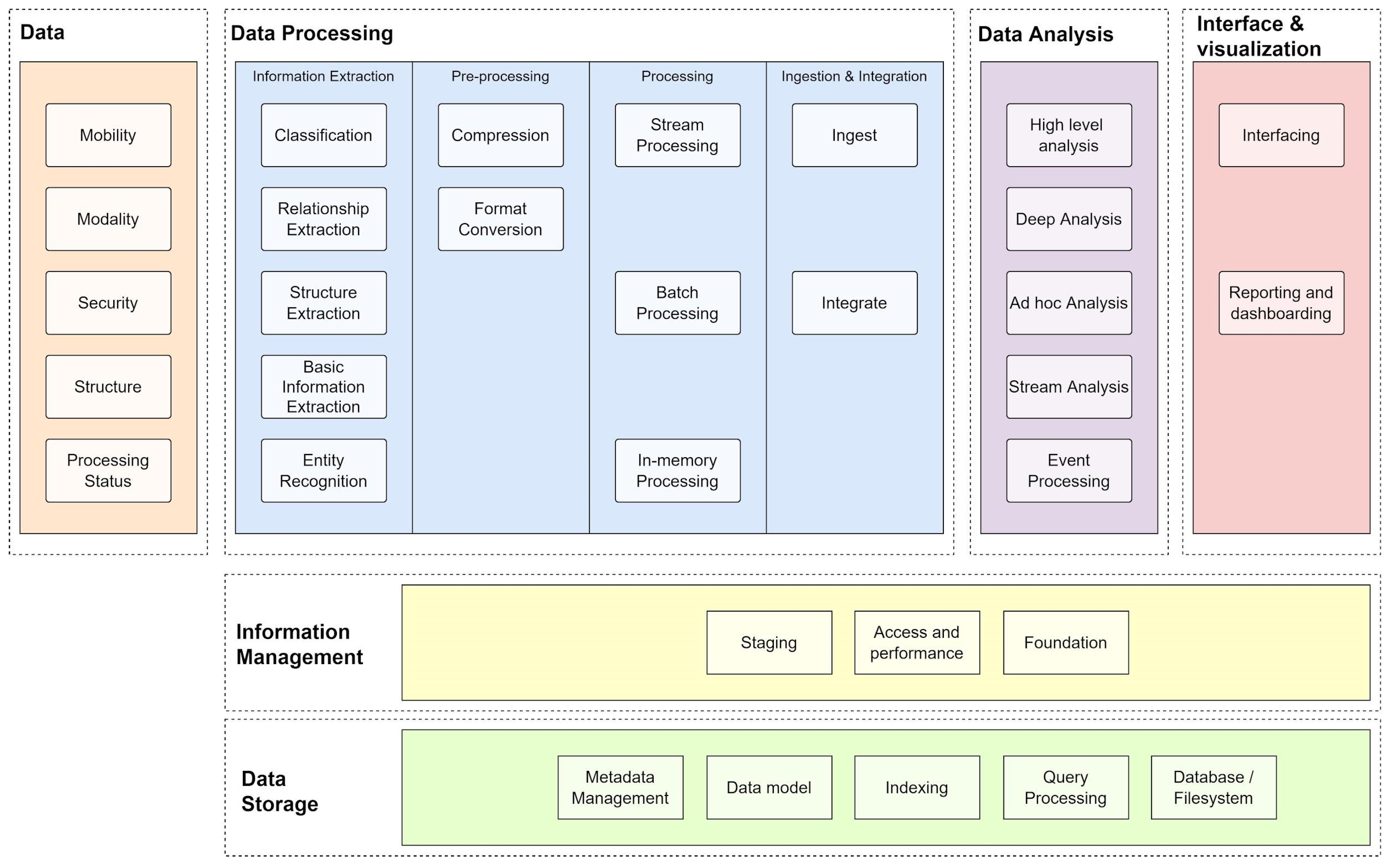



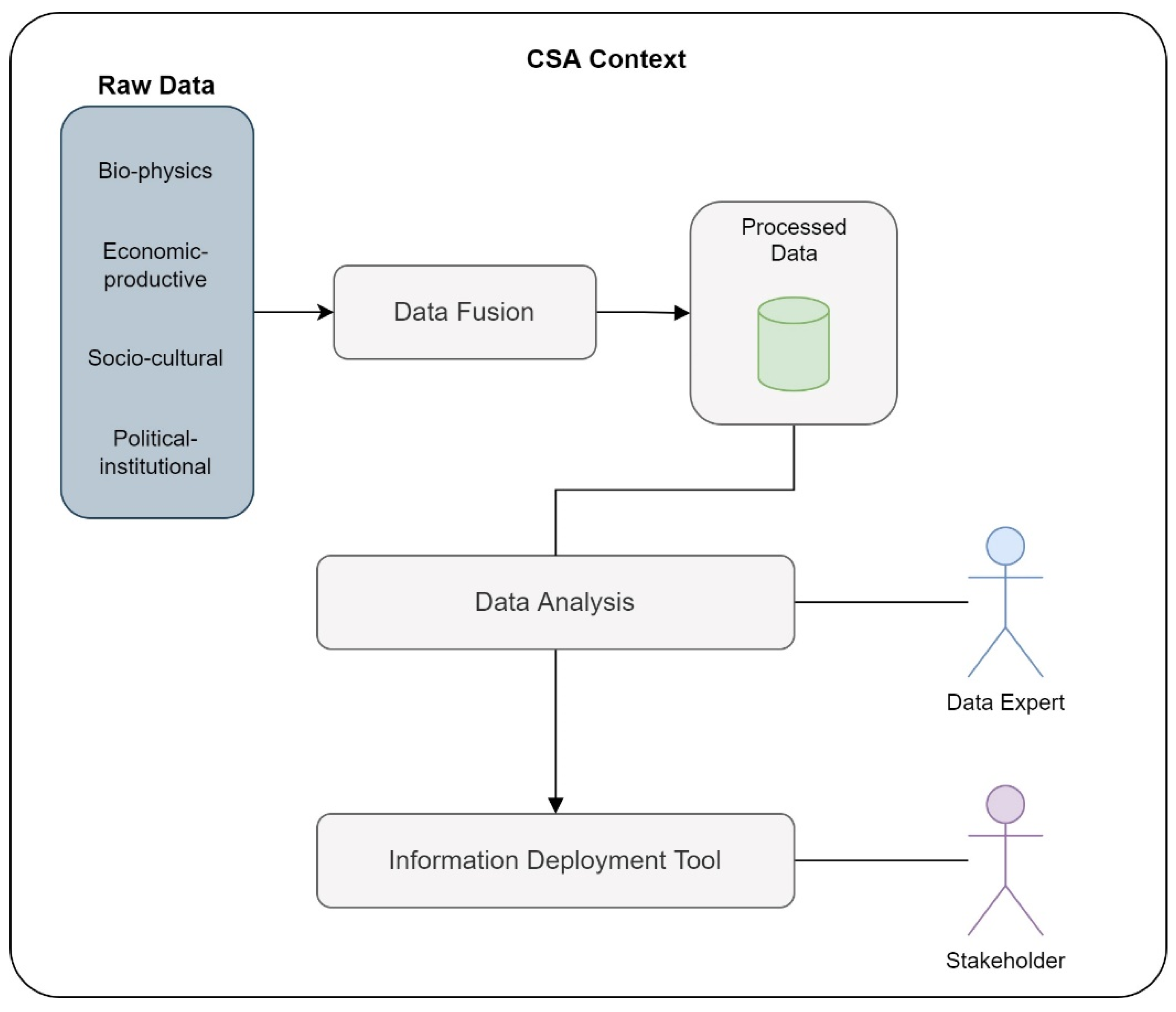
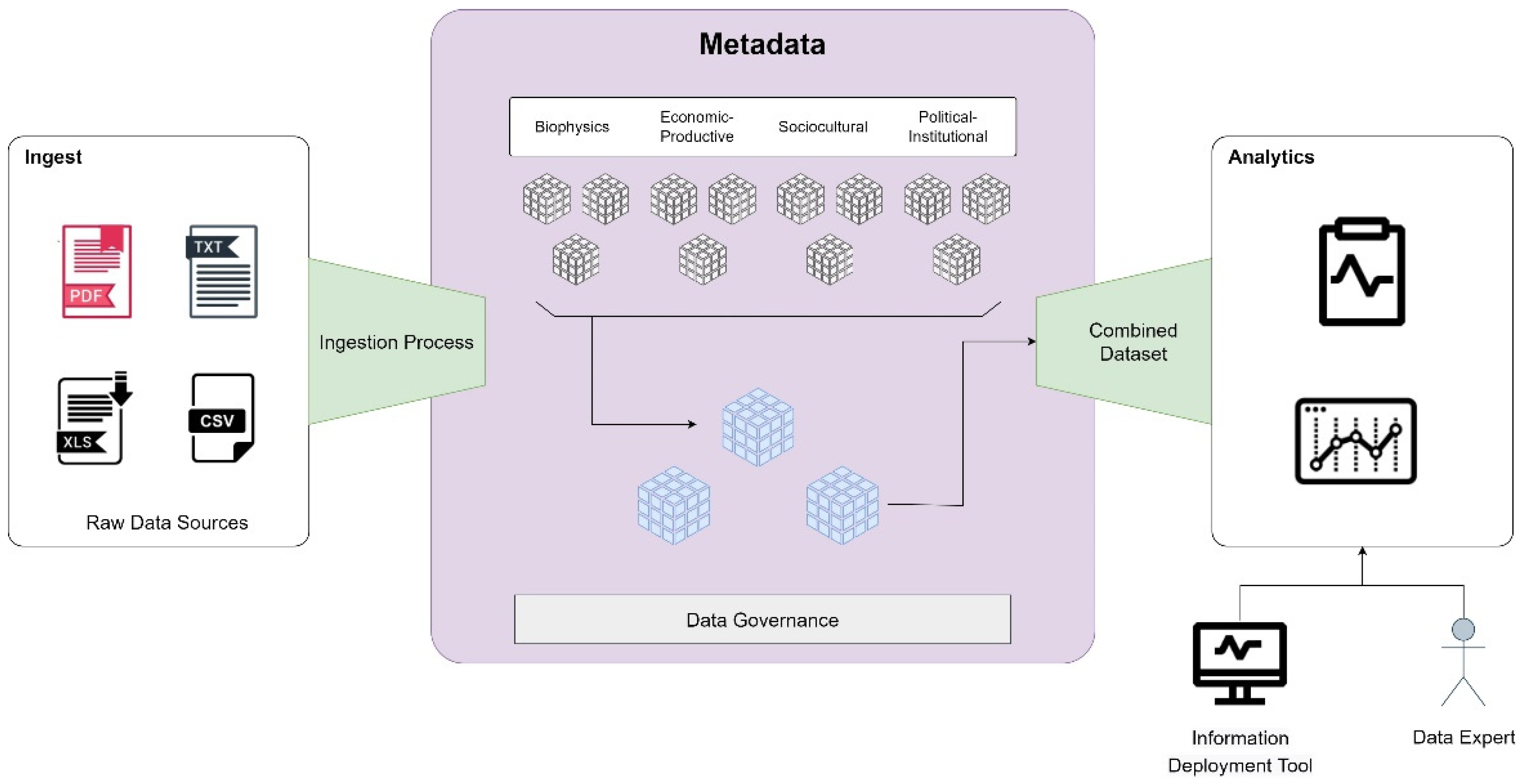

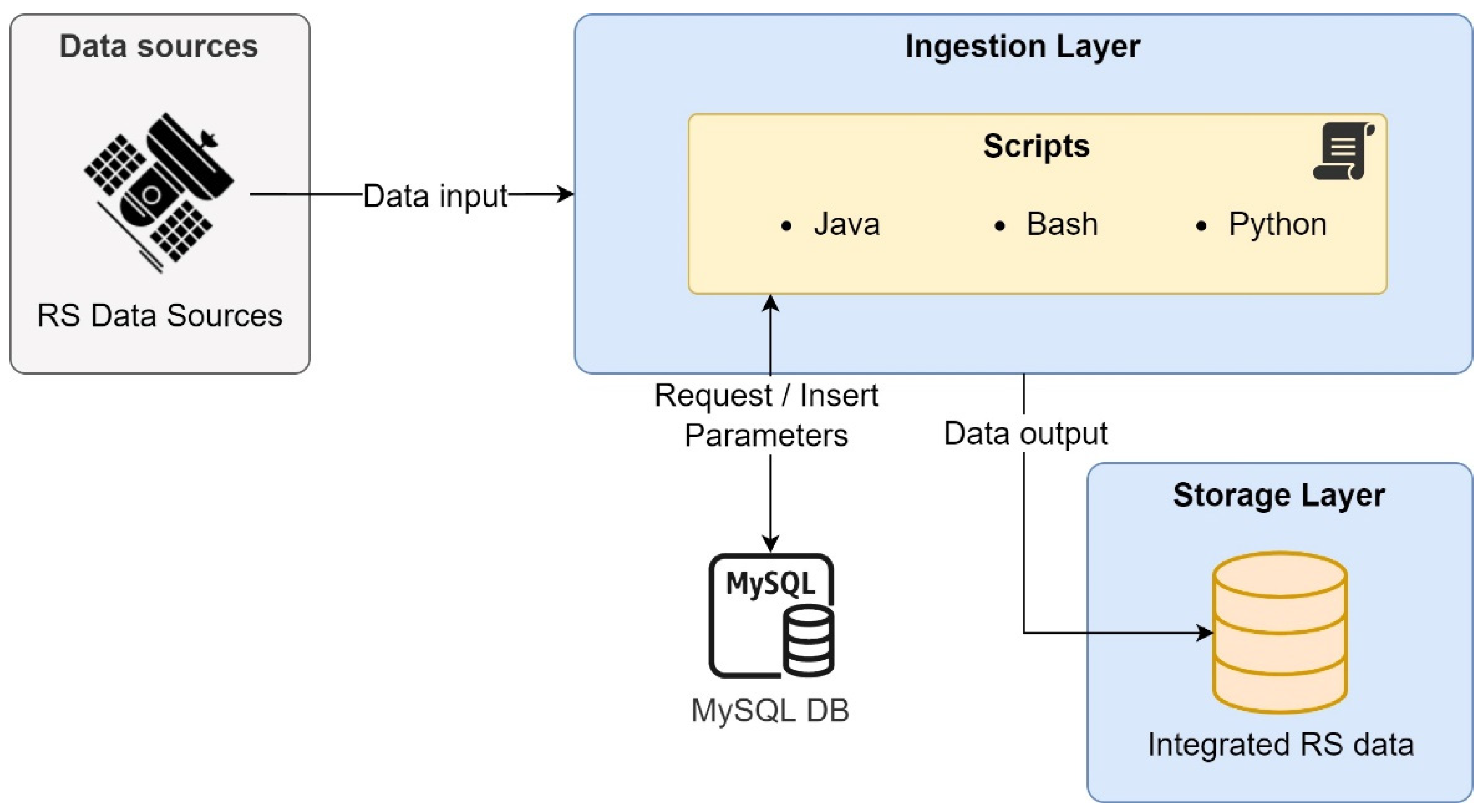


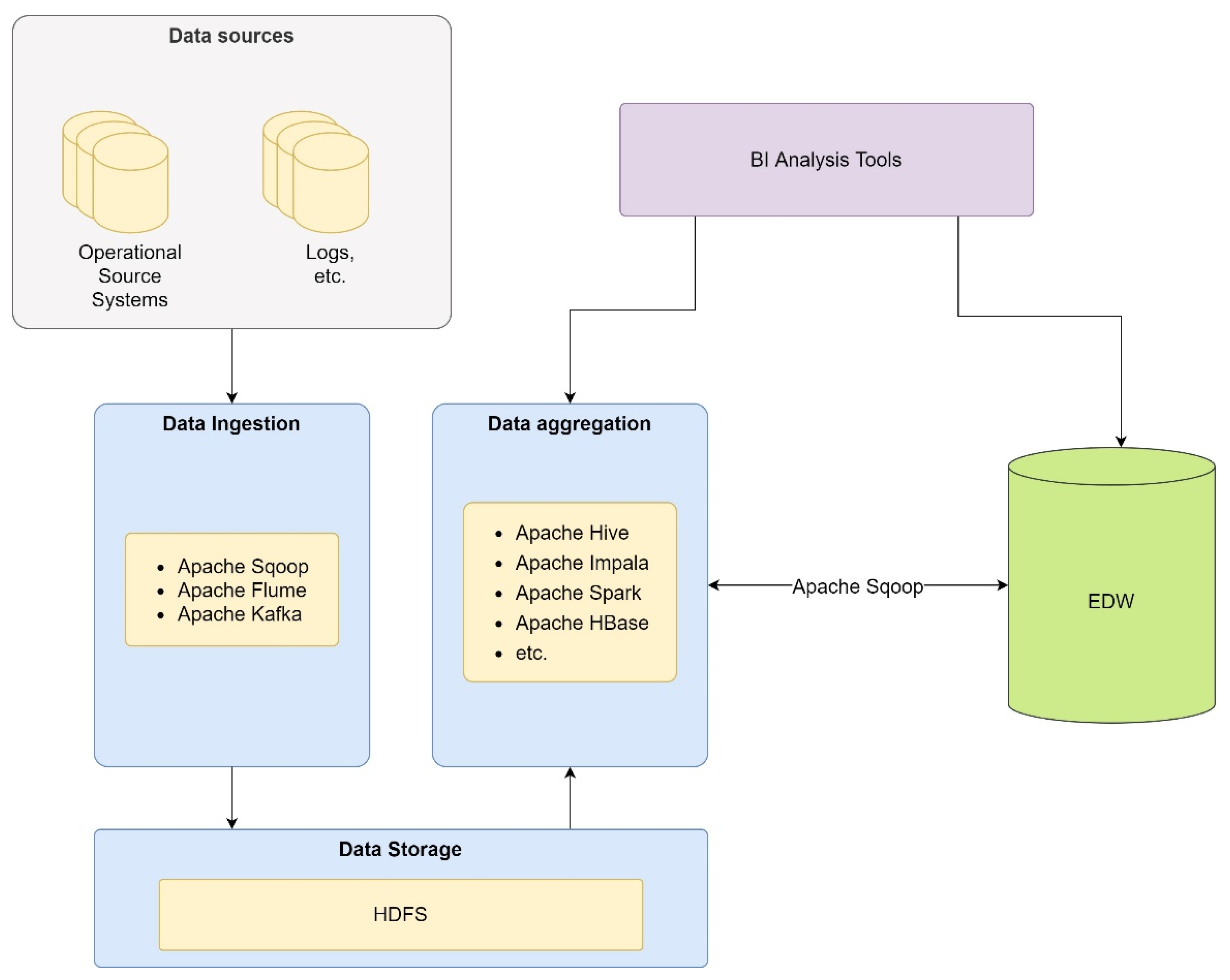
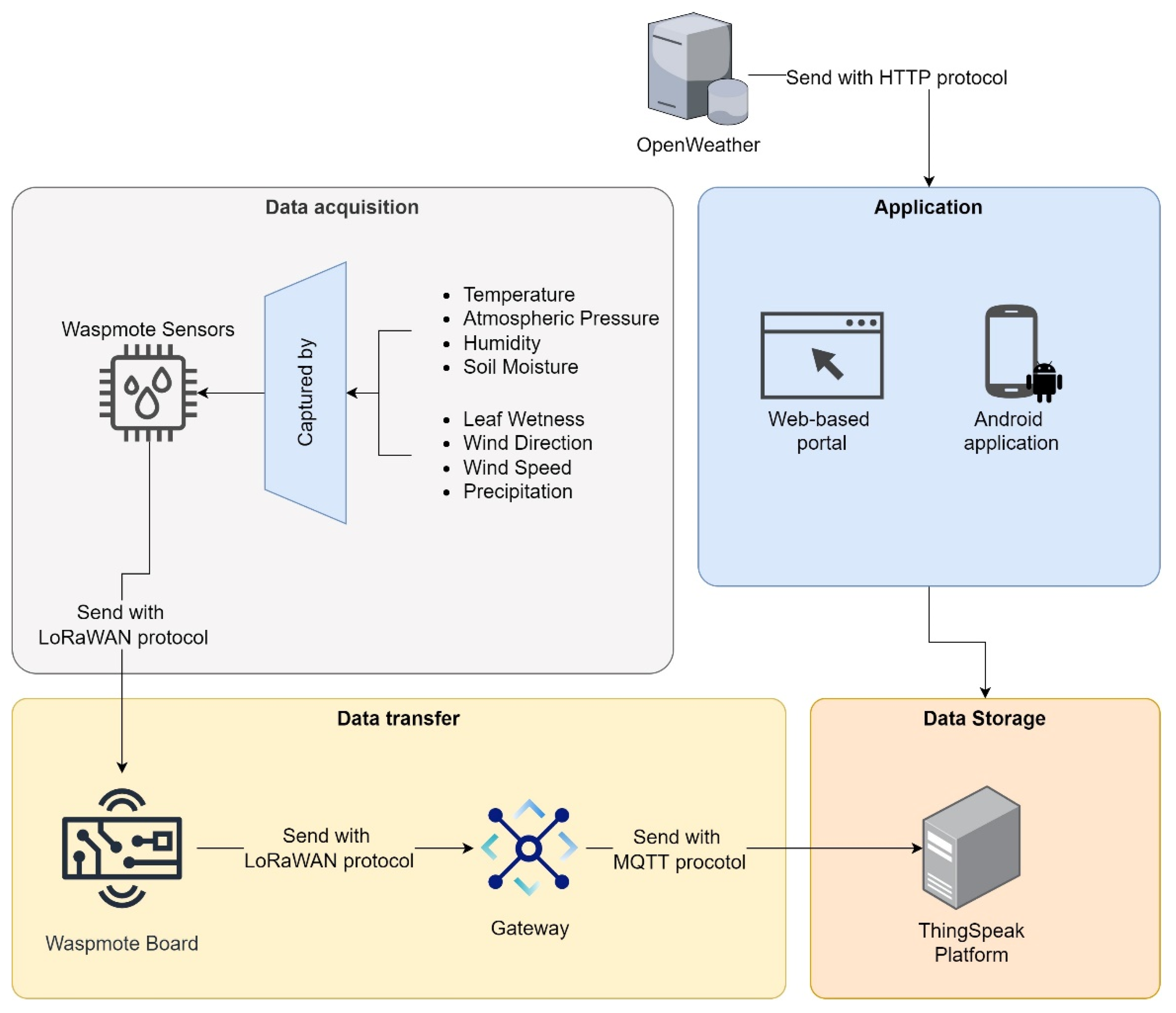
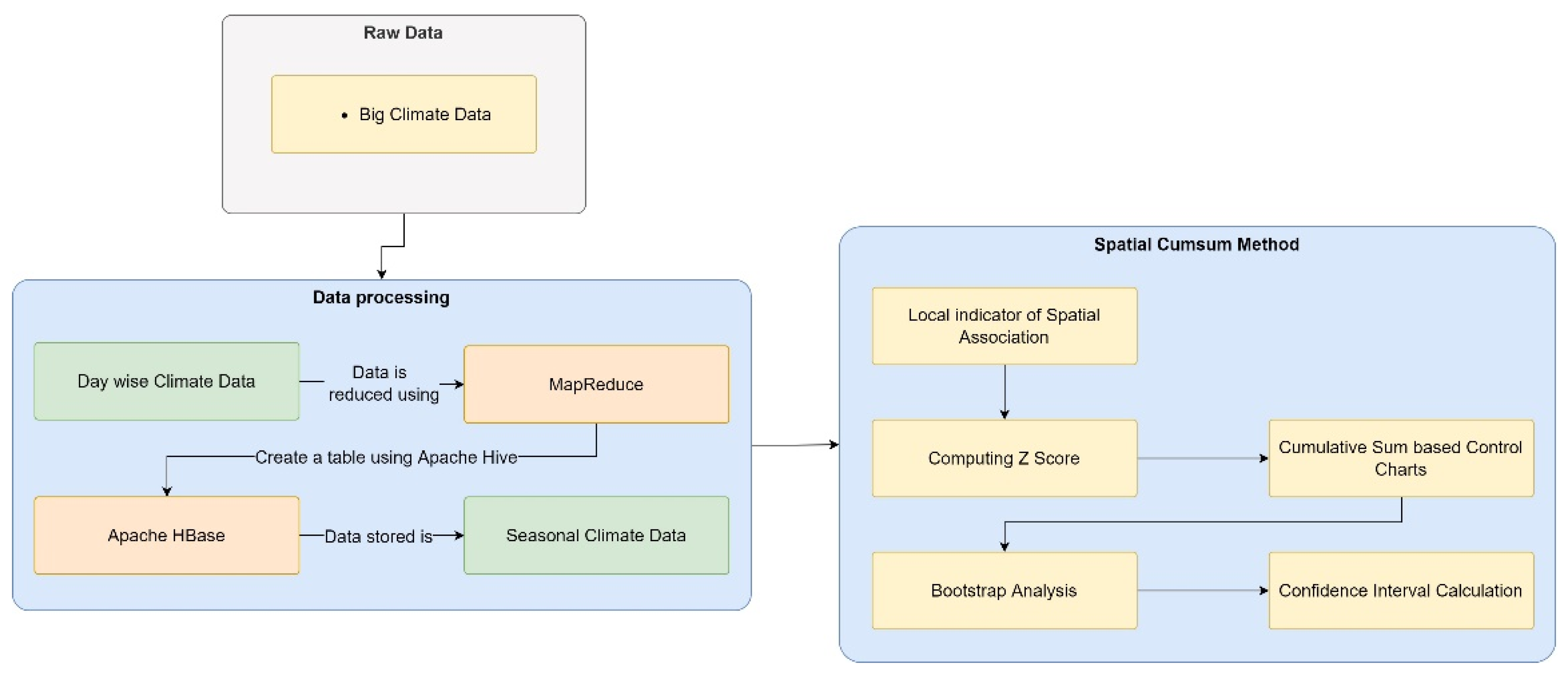


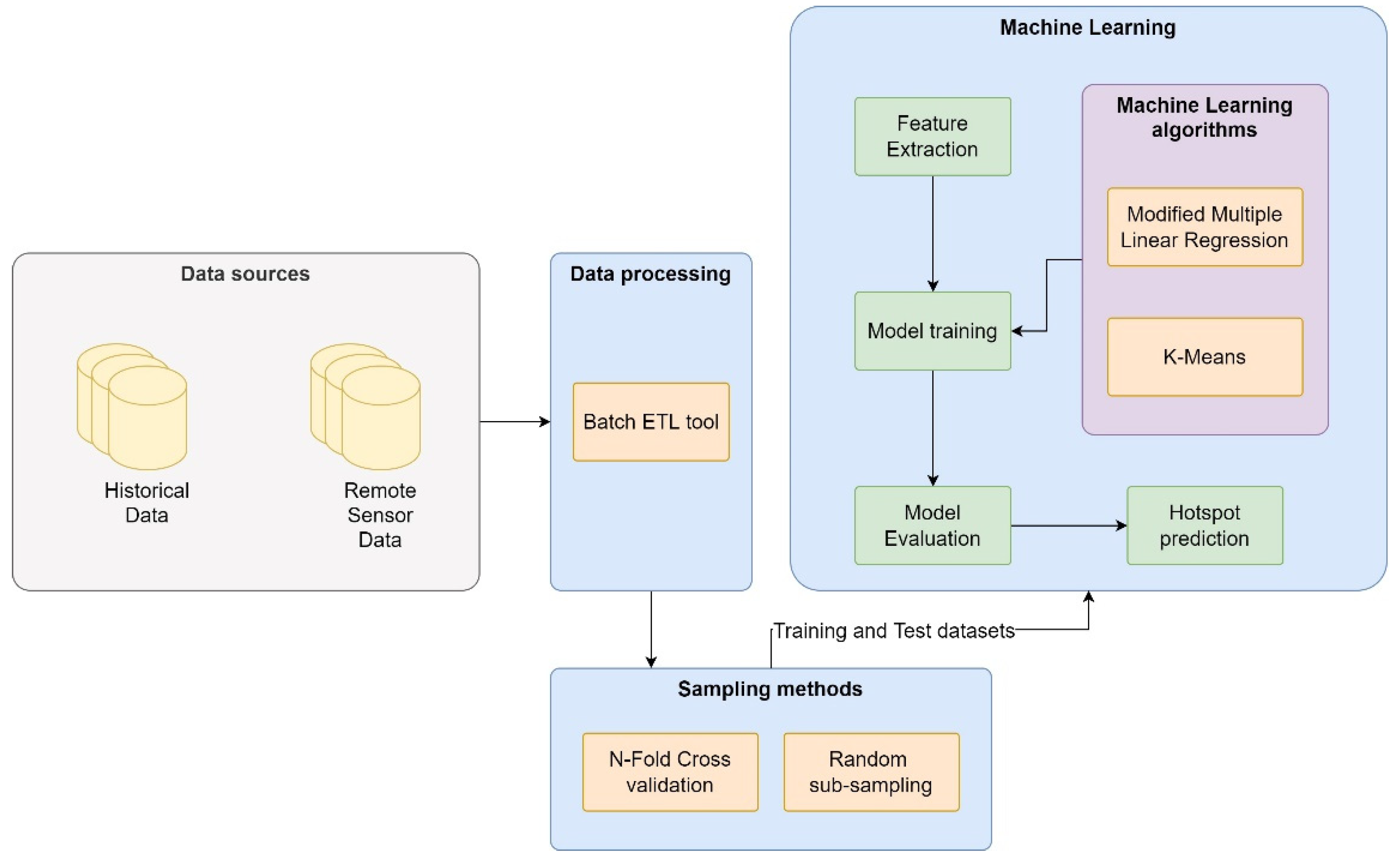
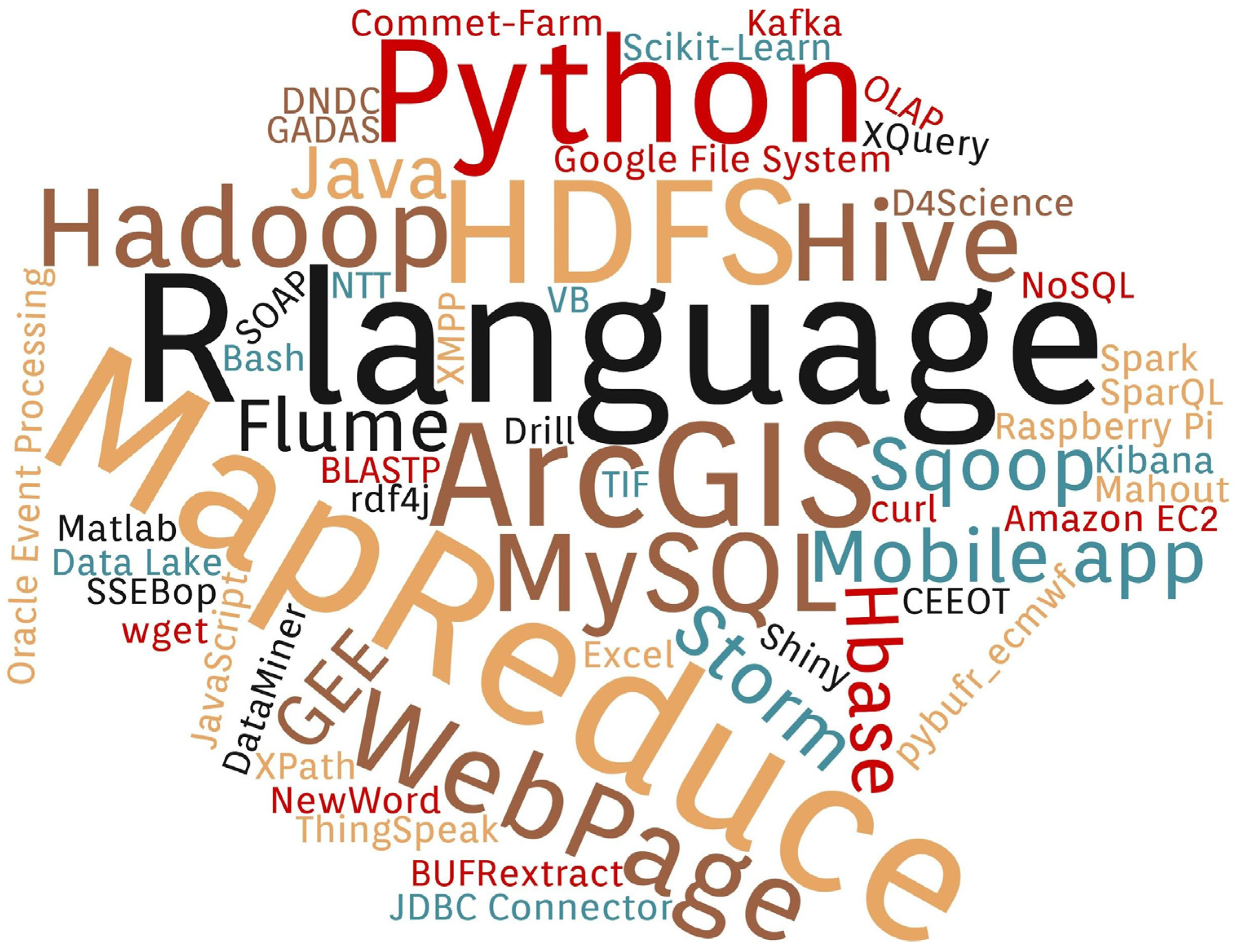
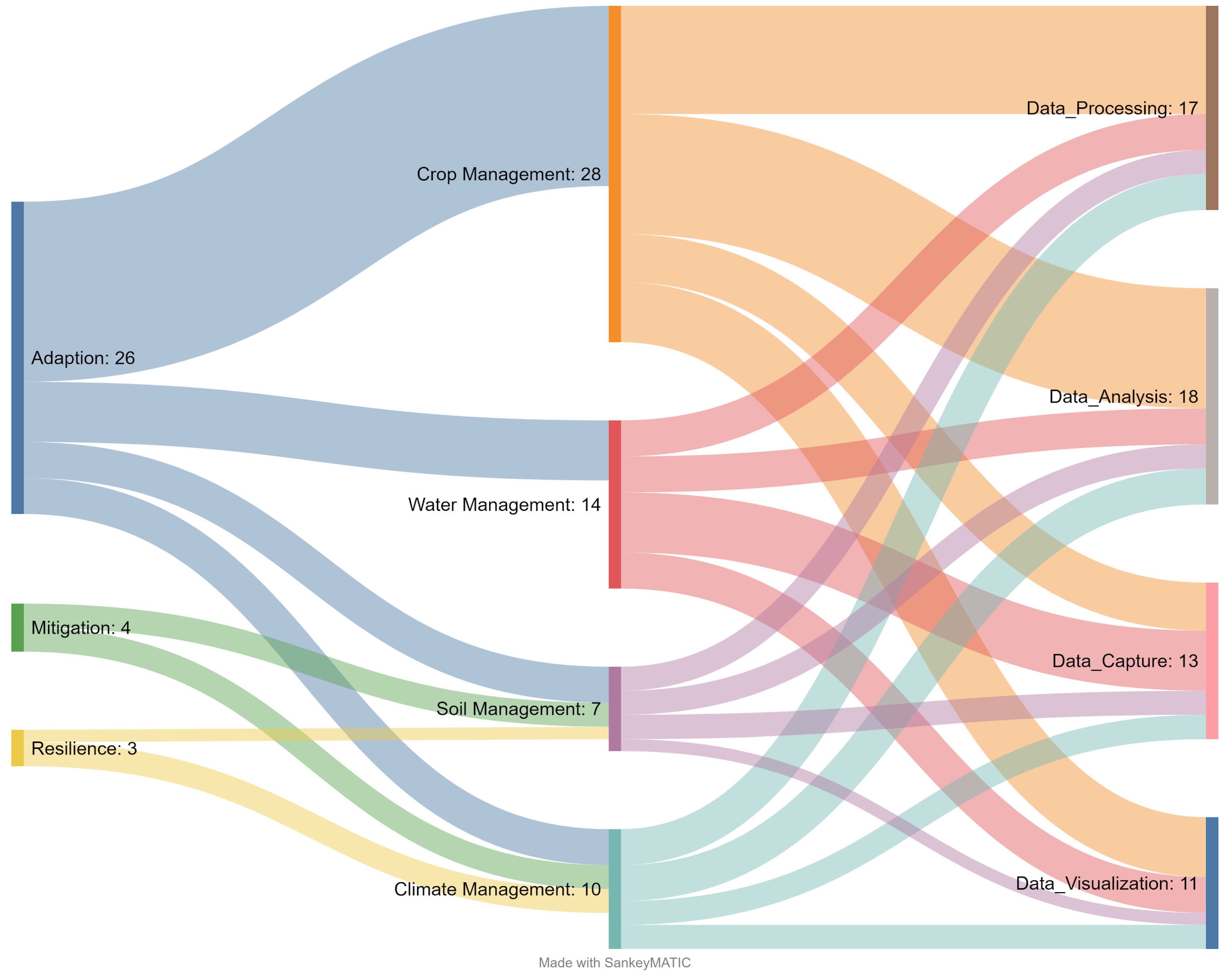
Publisher’s Note: MDPI stays neutral with regard to jurisdictional claims in published maps and institutional affiliations. |
© 2022 by the authors. Licensee MDPI, Basel, Switzerland. This article is an open access article distributed under the terms and conditions of the Creative Commons Attribution (CC BY) license (https://creativecommons.org/licenses/by/4.0/).
Share and Cite
Cravero, A.; Bustamante, A.; Negrier, M.; Galeas, P. Agricultural Big Data Architectures in the Context of Climate Change: A Systematic Literature Review. Sustainability 2022, 14, 7855. https://doi.org/10.3390/su14137855
Cravero A, Bustamante A, Negrier M, Galeas P. Agricultural Big Data Architectures in the Context of Climate Change: A Systematic Literature Review. Sustainability. 2022; 14(13):7855. https://doi.org/10.3390/su14137855
Chicago/Turabian StyleCravero, Ania, Ana Bustamante, Marlene Negrier, and Patricio Galeas. 2022. "Agricultural Big Data Architectures in the Context of Climate Change: A Systematic Literature Review" Sustainability 14, no. 13: 7855. https://doi.org/10.3390/su14137855
APA StyleCravero, A., Bustamante, A., Negrier, M., & Galeas, P. (2022). Agricultural Big Data Architectures in the Context of Climate Change: A Systematic Literature Review. Sustainability, 14(13), 7855. https://doi.org/10.3390/su14137855







